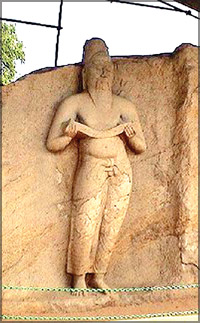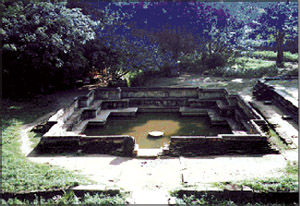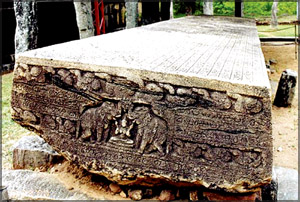Some well-known monuments
 Sri
Lanka is home to a host of monuments spanning across many kingdoms and
centuries. They are found in almost all parts of the country and belong
to many different eras in the history of this island. Today, we feature
some of these attractions which have captivated both locals and
foreigners alike. Sri
Lanka is home to a host of monuments spanning across many kingdoms and
centuries. They are found in almost all parts of the country and belong
to many different eras in the history of this island. Today, we feature
some of these attractions which have captivated both locals and
foreigners alike.
Maligawila Temple
|

Dambegoda Bodhisattva statue |
The Maligawila Temple lies about 15 kilometres off the Buttala town
towards Okkampitiya. Its famous seventh century statue was discovered
fallen and broken into pieces in 1951. An unsuccessful attempt to raise
this statue was made in 1974. However, a local engineering team managed
to raise this statue and restore it back to its former glory in 1980.
This statue is carved out of a single limestone and stands about 14.5
metres high; it is the tallest free-standing Buddha image in the
country. It is believed to have been created by a prince called
Aggabodhi who ruled the 'Rohana' region of Sri Lanka in the seventh
century. There had been an image house surrounding this gigantic statue;
its remains can still be seen.
About 500 metres away from this statue is another image carved out of
rock. This is thought to be the image of the Maithree Natha Bodhisattva,
sometimes known as Avalokitheswara Bodhisattva. This image is also known
as Dambegoda Bodhisattva statue.
Just left of the stairway to the Bodhisattva statue stands a
protected inscription on a pillar. This stone pillar had been created by
King Mahinda IV (956-972 AD) on his 10th year.
The inscription records the work done by the king to uplift Buddhism
and also the rules laid down by him to administer certain Buddhist
sites.
****
Sculpture of King Parakramabahu
 "Not
even one drop of water must flow into the ocean without being useful to
man" declared Parakramabahu the Great in the 12th century. This 3.5
metre (11 1/2 foot) rock sculpture of a barefoot man, clad only in what
appears to be a sarong, is believed to be that of the great king. "Not
even one drop of water must flow into the ocean without being useful to
man" declared Parakramabahu the Great in the 12th century. This 3.5
metre (11 1/2 foot) rock sculpture of a barefoot man, clad only in what
appears to be a sarong, is believed to be that of the great king.
The statue is situated just north of the town of Polonnaruwa, near
the eastern bank of the king's greatest achievement, the Parakrama
Samudra (Sea of Parakrama). This man-made tank covers an area of 6,000
acres (2,430 hectares) and supplies water to a vast area through 11
irrigation canals and minor tanks.
But there is another school of thought that this statue is that of a
sage holding a stack of manuscripts written on ola (cured palm) leaves.
***
Nelum Pokuna
 The
ponds found at Polonnaruwa are of comparatively modest dimensions. The
Nelum Pokuna (lotus pond) is also a small stone pond of a completely
unique design, built in levels of eight petalled lotuses in descending
form. The
ponds found at Polonnaruwa are of comparatively modest dimensions. The
Nelum Pokuna (lotus pond) is also a small stone pond of a completely
unique design, built in levels of eight petalled lotuses in descending
form.
The fine cut granite is in excellent condition and provides a nice
view to all visitors. Its garden-like surroundings, with its ancient
flowering trees enhance the magnificence of the area.
The chronicles speak of a lotus pond among the many ponds constructed
by Parakramabahu the Great. It is believed to be the pond provided by
the king for the monks belonging to the Jetavana Vihara.
****
Ath Pokuna
Have you heard about the marvellous waterway system in Sigiriya? Our
ancient kings employed great technology to work with water and this pond
is an example of that.
This 10-metre deep public pool was just one of the ponds built north
of the Abhayagiri University complex in Anuradhapura. It was connected
to a network of underground tunnels that brought water from several
reservoirs. Archaeologists were amazed to discover three stages of water
filters made of stone here. Only water filtered three times by these
filters would reach the Ath Pokuna.
One of the key underground water lines was from the Perimiyankulam
reservoir in Vanni. This water line, with automatic pressure systems,
still works. On rainy days, the Ath Pokuna still gets water through
these underground tunnels.
***
Kumara Pokuna
 The
Kumara Pokuna is a systematically built bath for royals in Pollonnaruwa.
This pond made of stone slabs could be reached after passing the Royal
Court of King Parakramabahu. It had been used in the time of King
Parakramabahu (1153-1186). The
Kumara Pokuna is a systematically built bath for royals in Pollonnaruwa.
This pond made of stone slabs could be reached after passing the Royal
Court of King Parakramabahu. It had been used in the time of King
Parakramabahu (1153-1186).
The water to fill the baths had been diverted through underground
channels from the Parakrama Samudra. The changing rooms stand alongside
the baths and had been equipped with toilet facilities as well.
****
Gal Potha
 King
Nissankamalla, heir to the Great King Parakramabahu, wanted the world to
know of his achievements, so he had these achievements inscribed in
glowing terms on the Gal Potha, an enormous stone slab beside the
temple. King
Nissankamalla, heir to the Great King Parakramabahu, wanted the world to
know of his achievements, so he had these achievements inscribed in
glowing terms on the Gal Potha, an enormous stone slab beside the
temple.
This huge stone slab was apparently brought over from Mihintale, some
60 miles (100 kilometres) away, and is about 26 feet (eight metres)
long. It is one of the most famous works of King Nissankamalla
(1187-1196) and describes himself, his rule and the eligibility for
being a king of Sri Lanka. The text is written in three columns and
contains over 4,300 characters in 72 lines.
There are signs that liquified metal had been pored onto the carved
characters to make the letters much clearer.
Janani Amarasekara |
